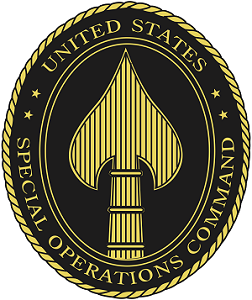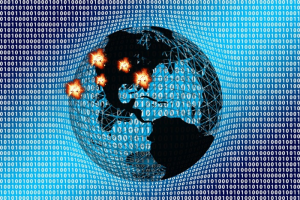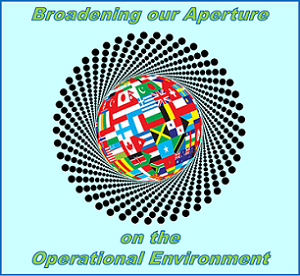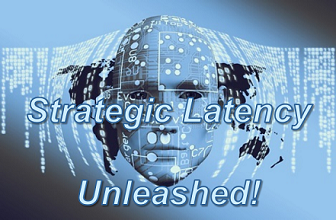“The ability to learn faster than competitors may be the only sustainable competitive advantage.” — Arie de Geusi
[Editor’s Note: Mad Scientist is pleased to feature today’s post, excerpted from Strategic Latency Unleashed: The Role of Technology in a Revisionist Global Order and the Implications for Special Operations Forces, edited by Dr. Zachary S. Davis, Dr. Frank Gac, Christopher Rager, Philip Reiner, and Lt. Col. Jennifer “JJ” Snow, and published by the Center for Global Security Research, Lawrence Livermore National Laboratory, on behalf of Special Operations Command (SOCOM).  In reviewing its table of contents, one is struck by how many of the contributing national security experts and operators are proclaimed Mad Scientists! Indeed, special thanks goes out to proclaimed Mad Scientist Lt. Col. Snow for bringing this timely and important document to our attention, for introducing us to Dr. Davis (co-editor and author of its Introduction — the subject of today’s post), and making our upcoming The Convergence podcast episode with Dr. Davis and proclaimed Mad Scientist and Undersecretary of the Navy, the Honorable James “Hondo” Geurts (author of its Foreword) possible — more about this podcast, below. While developed at the behest of SOCOM to inform the Special Operations Forces (SOF) community, this document illuminates important trends that are just as relevant to the U.S. Army and conventional warfighters as they are to special forces — there is only one operational environment, and the lines between competition and conflict, regular and irregular warfare, and kinetic and gray zone operations continue to blur — Read on!]
In reviewing its table of contents, one is struck by how many of the contributing national security experts and operators are proclaimed Mad Scientists! Indeed, special thanks goes out to proclaimed Mad Scientist Lt. Col. Snow for bringing this timely and important document to our attention, for introducing us to Dr. Davis (co-editor and author of its Introduction — the subject of today’s post), and making our upcoming The Convergence podcast episode with Dr. Davis and proclaimed Mad Scientist and Undersecretary of the Navy, the Honorable James “Hondo” Geurts (author of its Foreword) possible — more about this podcast, below. While developed at the behest of SOCOM to inform the Special Operations Forces (SOF) community, this document illuminates important trends that are just as relevant to the U.S. Army and conventional warfighters as they are to special forces — there is only one operational environment, and the lines between competition and conflict, regular and irregular warfare, and kinetic and gray zone operations continue to blur — Read on!]
“Is it me, or is it getting crazier out there?” — The Joker (2019)
It didn’t have to be like this. The world could have evolved in different ways — toward a tranquil state marked by peace and cooperation, or on a trajectory of  expanding chaos and violence. The current geopolitical situation is somewhere in the middle. While scholars analyze global politics and policy makers set the course of action, U.S. Special Operations Forces (SOF) adapt to both the peaceful and chaotic aspects of the operational environment to achieve mission objectives. Strategic Latency Unleashed: The Role of Technology in a Revisionist Global Order and the Implications for Special Operations Forces contemplates the changing conditions under which SOF must operate and the role technology plays in making their jobs harder in some ways and easier in others.
expanding chaos and violence. The current geopolitical situation is somewhere in the middle. While scholars analyze global politics and policy makers set the course of action, U.S. Special Operations Forces (SOF) adapt to both the peaceful and chaotic aspects of the operational environment to achieve mission objectives. Strategic Latency Unleashed: The Role of Technology in a Revisionist Global Order and the Implications for Special Operations Forces contemplates the changing conditions under which SOF must operate and the role technology plays in making their jobs harder in some ways and easier in others.
“Strategic latency” refers to the potential for technologies to shift the balance of power among nation-states. ii 1 “Strategic” effects have major, long-term consequences (in contrast to tactical effects that may be important but not game-changing). Latent power — expressed in the full range of military, economic, and political forms — can be unleashed to enable tools that people use to achieve their objectives. From the Stone Age to the Information Age, humans have wavered between peaceful and violent goals. Technology magnifies humanity’s dual nature, predisposed to perform both good and evil deeds. Peering into the future, nothing suggests this fundamental truth will change. Thus, we should expect both conflict and warfare to endure and for SOF to play a leading role in future conflict. If war is an expression of “politics by other means,” then technology will provide the soft- and hard-power tools with which wars will be fought. Therefore, SOF will have to employ appropriate technologies to ensure success in the evolving operational environment.

While human nature stays the same, other things are changing. The operational environment of world politics is undergoing a historic transformation. Nation-states remain the primary actors on the world stage, but the global balance of power is in flux. The “Long Peace” of the Cold War yielded to an interlude of American supremacy, followed by the current period of shuffling and realignment in which state and non-state actors are challenging the norms, institutions, and alliances favored by the United States. The rules established to support the post–World War II global order are showing signs of weakness and decay. Countries and non-state actors have violated international norms and treaties such as those prohibiting chemical weapons use, nuclear testing, and nuclear proliferation.
How much longer will the postwar norms hold, especially without verification or enforcement? Increasingly, key U.S. allies question the security guarantees provided to address their fears of hostile neighbors, raising concerns they may break ranks to acquire nuclear, chemical, or biological capabilities. Rising  powers, such as China, and revanchist states such as Russia and Iran welcome the demise of the aging American-led order, while nationalist movements around the world reject the core values of freedom and democracy that defined the American century. Tectonic geopolitical shifts are underway in Asia, Europe, and the Middle East, spilling into Africa and the Americas. Multi-continent mass migrations from poverty and violence have sparked fear and resentment from those who see refugees and immigrants as threats. Climate change is producing extreme weather, causing natural disasters and resource scarcity that directly affects the operational environment.2 This is the new world that SOF encounters.
powers, such as China, and revanchist states such as Russia and Iran welcome the demise of the aging American-led order, while nationalist movements around the world reject the core values of freedom and democracy that defined the American century. Tectonic geopolitical shifts are underway in Asia, Europe, and the Middle East, spilling into Africa and the Americas. Multi-continent mass migrations from poverty and violence have sparked fear and resentment from those who see refugees and immigrants as threats. Climate change is producing extreme weather, causing natural disasters and resource scarcity that directly affects the operational environment.2 This is the new world that SOF encounters.
Further complicating the situation, a new generation of non-state actors populate the landscape. Global corporations, many with no allegiances beyond their bottom line, pursue interests largely beyond the reach of nation-states. Activist groups advocate on behalf of people, animals, and myriad social causes, forming identities more tied to particular ideology than to national allegiance. Violent extremist organizations continue to thrive in the chaotic and ungoverned corners of the world, yet their messages of hate reach millions through social media, sometimes inspiring terrorism and rebellion. A common theme running throughout this changing ecosystem of states, groups, and individuals is the role of technology in giving force to their actions. How can U.S. SOF find advantage amidst these conditions?
In contrast to the constancy of human nature, technology is changing at breakneck speed. Scientific discovery is accelerating, aided by the input of massive resources from governments and industries aimed at winning global competition for markets and influence, be it in communications, artificial intelligence, manufacturing, or health care. While U.S. Government–sponsored research and development has declined,3 rising powers such as China pour human and financial resources into science and technology intending to reap the military and economic benefits.4 Progress in the biological sciences, artificial intelligence, robotics, computation, and basic research fuels innovation in medicine, transportation, manufacturing, communications, and even entertainment. As the futurist Alvin Toffler  predicted, a third wave of technology-inspired revolutions is remaking societies on a global scale.5 The highly structured, brick-and-mortar industrial age is giving way to an era of non-hierarchical, individualized, instantaneous, global connectedness.
predicted, a third wave of technology-inspired revolutions is remaking societies on a global scale.5 The highly structured, brick-and-mortar industrial age is giving way to an era of non-hierarchical, individualized, instantaneous, global connectedness.
Often, technological changes reflect “the better angels of our nature” and bring improvements to the human condition. Sometimes, they serve the dark side of human nature and find expression as weapons of war. For example, fire, atomic energy, and computers have all fueled both peaceful and warfighting innovations. Gene editing and artificial intelligence may possess similar latent power. Interconnectivity ensures the latest scientific discoveries will be available to all and puts the commercial applications of those discoveries in the hands of anyone with a credit card. Facebook, Google, Amazon, and their competitors have often forgone notions of privacy to create new levels of association among people, places, and things. Such witting and unwitting connectedness empowers all-encompassing surveillance systems used simultaneously for communication, commerce, and repression. How will SOF navigate this shifting landscape?
 The Internet of Things promises even more connectivity. On the battlefield, a military version of the Internet of Things spans multiple domains, from subterranean and undersea, across the earth’s surface, and into the atmosphere and outer space. The latent potential of drones and robots has already caused rapid innovation from both nations and non-state actors. Interconnectedness begets data, which may soon challenge oil for its value as a strategic game changer. Echoing the words of the famous maritime strategist Alfred Mahan, “Whoever rules the waves rules the world,”6 Russian President Vladimir Putin proclaimed “Whoever rules in artificial intelligence will rule the world.”7 Control of data may indeed be a strategic asset, but its value lies in the insights it provides into human behavior. New tools may not change humanity’s fundamental nature, but they are changing how we live, govern, communicate, and fight.
The Internet of Things promises even more connectivity. On the battlefield, a military version of the Internet of Things spans multiple domains, from subterranean and undersea, across the earth’s surface, and into the atmosphere and outer space. The latent potential of drones and robots has already caused rapid innovation from both nations and non-state actors. Interconnectedness begets data, which may soon challenge oil for its value as a strategic game changer. Echoing the words of the famous maritime strategist Alfred Mahan, “Whoever rules the waves rules the world,”6 Russian President Vladimir Putin proclaimed “Whoever rules in artificial intelligence will rule the world.”7 Control of data may indeed be a strategic asset, but its value lies in the insights it provides into human behavior. New tools may not change humanity’s fundamental nature, but they are changing how we live, govern, communicate, and fight.
Some scholars argue the risks associated with these global trends pale in comparison to the prosperity that defines our age.8 Others view the risks as indicators of a gathering storm. One thing is certain: large-scale changes in geopolitics, spurred by technology, are changing the operational environment and, with it, the nature of warfare. For starters, the beginning and end of  conflicts are getting harder to define, with gray-zone tactics becoming commonplace even in peacetime. Borders provide little protection from aggressors, and the distinction between friends and enemies, be they nation-states or otherwise, is similarly blurred. Relatedly, the distinction between combatants and noncombatants has grown increasingly unclear. Even the rules of war are blurring, raising ethical questions about the uses of force, especially as the battlefield becomes less defined by physical or temporal boundaries and new weapons open uncharted paths of conflict and competition. To further confuse the situation, social media distorts perceptions of reality, exacerbating political differences.
conflicts are getting harder to define, with gray-zone tactics becoming commonplace even in peacetime. Borders provide little protection from aggressors, and the distinction between friends and enemies, be they nation-states or otherwise, is similarly blurred. Relatedly, the distinction between combatants and noncombatants has grown increasingly unclear. Even the rules of war are blurring, raising ethical questions about the uses of force, especially as the battlefield becomes less defined by physical or temporal boundaries and new weapons open uncharted paths of conflict and competition. To further confuse the situation, social media distorts perceptions of reality, exacerbating political differences.
U.S. SOF must be prepared to meet a broad and growing array of challenges. When shadow wars are a constant background to international relations, and the spectrum of conflict extends from great power and peer competition through regional conflicts and proxy wars, calibrating effective SOF  capabilities is more complex than ever. With more parties using an expanding toolbox of measures short of war to shape the environment, understanding the evolving threats to U.S. security requires new insights. We must think differently. The purpose of this book is to open pathways for those new insights as they apply to the mission of U.S. SOF. Fortunately, adapting to new threats is a notable strength of American SOF. Innovation is a defining trait. SOCOM’s experience fighting terrorism in the post-9/11 world provides many examples of the type of adaptation that is required for the new environment. Countering terrorism requires constant innovation in tactics and tools, in part because the practitioners of terror are themselves motivated innovators. Similarly, SOCOM’s evolving role in countering weapons of mass destruction has spurred new approaches. This book is part of the effort to understand the threats, mobilize a response, and prepare U.S. commandos with the tools they need to win.
capabilities is more complex than ever. With more parties using an expanding toolbox of measures short of war to shape the environment, understanding the evolving threats to U.S. security requires new insights. We must think differently. The purpose of this book is to open pathways for those new insights as they apply to the mission of U.S. SOF. Fortunately, adapting to new threats is a notable strength of American SOF. Innovation is a defining trait. SOCOM’s experience fighting terrorism in the post-9/11 world provides many examples of the type of adaptation that is required for the new environment. Countering terrorism requires constant innovation in tactics and tools, in part because the practitioners of terror are themselves motivated innovators. Similarly, SOCOM’s evolving role in countering weapons of mass destruction has spurred new approaches. This book is part of the effort to understand the threats, mobilize a response, and prepare U.S. commandos with the tools they need to win.
To cope with these changes, however, it is not enough to perfect the “hyper-enabled operator”9 or simply increase the range and lethality of the warfighter. Fortunately, the enduring SOF Truths10 provide sturdy concepts for dealing with today’s chaos and complexity. The five SOF Truths are listed below in quotations, followed by the author’s comments as to how they apply to this chapter and book.
“Humans are more important than hardware.”
Technology tools simply enable people to achieve their objectives. Understanding the constants of human nature provides insight into the intentions of our allies and adversaries. Tools are never more important than people. Technology must serve strategy.
“Quality is better than quantity.”
What makes SOF special is the ability to understand and exploit the operational environment. Knowing which tools/technologies to use in specific circumstances and how to apply them requires uncommon knowledge of multiple disciplines. Such knowledge is rare but essential for SOF to deal with complexity and chaos. Knowledge is power.
“Special operations forces cannot be mass produced.”
SOF are effective for certain missions but are not suited for all forms of conflict. Small teams of extraordinarily skilled, trained, equipped, and supported operators are tailored for speed, precision, stealth, and low visibility. This specialized capability augments general purpose forces and represents a small faction within the broader context of military, diplomatic, intelligence, and economic tools of statecraft. One objective of this project is to identify tools to maximize the reach, effectiveness, and resilience of limited SOF resources.
“Competent SOF cannot be created after emergencies occur.”
The Covid-19 pandemic of 2020 illustrated the problems that arise from trying to compensate for a lack of preparedness after the crisis has already struck. SOF cannot wait and react to the changes that are occurring in the world. We are preparing now for tomorrow’s challenges. This book takes stock of the emerging operational environment and offers possible solutions to prepare SOF for future exigencies.
“Most special operations require non-SOF assistance.”
To cope with complexity, SOF must deepen its relationships with a broad swath of society that is knowledgeable about the technologies and social movements behind the changes taking place in the world. This includes the private sector, academia, and people associated with unconventional points of view who can provide insights into the current situation. Beyond  relying on general purpose forces, foreign partners, and the full range of capabilities available in the U.S. Government, SOF must engage with an expanding range of diverse, multidisciplinary, global perspectives, such as those presented here.
relying on general purpose forces, foreign partners, and the full range of capabilities available in the U.S. Government, SOF must engage with an expanding range of diverse, multidisciplinary, global perspectives, such as those presented here.
Taking guidance from these SOF Truths, and with full appreciation for SOF’s Core Activities,iii 11 we have gathered a group of top experts from multiple disciplines, along with current and former SOF operators, to view developments in geopolitics, technology, and business through the eyes of American SOF. The book provides a compendium of SOF-relevant topics to illuminate important trends for irregular and unconventional warfare. The accompanying Mixonium multimedia platform [the password is Beyond;20] offers additional insights and resources to those interested in these topics. The project intends to spark conversation and debate about these issues, so we invite you to join the discussion. Our contact information is available in this volume and on the Mixonium pages.
If you enjoyed this post, stay tuned to the Mad Scientist Laboratory, as our next episode of The Convergence podcast will feature our interview with the Undersecretary of the Navy, the Honorable James “Hondo” Geurts and today’s author, Dr. Zachary Davis, discussing Strategic Latency Unleashed: The Role of Technology in a Revisionist Global Order and the Implications for Special Operations Force and how to think radically about the future, capitalize on talent, and unleash technological convergences to out-compete our adversaries, and when necessary, defeat them decisively in conflict, this Thursday, 15 April 2021…
… and check out the following related content:
“Once More unto The Breach Dear Friends”: From English Longbows to Azerbaijani Drones, Army Modernization STILL Means More than Materiel and Making the Future More Personal: The Oft-Forgotten Human Driver in Future’s Analysis, by Ian Sullivan
Sub-threshold Maneuver and the Flanking of U.S. National Security, by Dr. Russell Glenn
The Convergence: Hybrid Threats and Liminal Warfare with Dr. David Kilcullen, the associated podcast, and the video [access via a non-DoD network] and notes from Mad Scientist’s Operational Environment and Conflict over the Next Decade webinar on 19 January 2021, featuring Dr. T.X. Hammes. Dr. David Kilcullen, and Dr. Sean McFate
Competition and Conflict in the Next Decade
The Convergence: The Future of Ground Warfare with COL Scott Shaw, and associated podcast
Delta-V, by Chris Elles
The Convergence: Changing Mindsets for the Future with Dr. Lydia Kostopoulos and associated podcast
The Convergence: Innovating Innovation with Molly Cain and associated podcast
Estimation of Technological Convergence by 2035, and the associated final report and briefing slides, by Lt Col Nicholas Delcour (USAF), Lt Col Louis Duncan (USAF), Mr. Stephen Frahm (DOS), CDR Patrick Lancaster (USN), and Lt Col Lance Vann (USAF), collectively known as the Army War College’s Mad Scientist Fellows of 2020, under the direction of Prof. Kristan Wheaton, U.S. Army War College
>>>> REMINDER: If you have not yet done so, REGISTER NOW for our Climate Change – Threats, Resilience, and Adaptation webinar, tomorrow, Tuesday, 13 April 2021 (1430-1600 EDT). Join our panelists:
-
-
- Dr. Elizabeth Chalecki, Associate Professor of International Relations, University of Nebraska – Omaha, and Wilson Fellow, Woodrow Wilson International Center for Scholars
-
-
-
- Dr. Anne Marie Baylouny, Associate Professor of National Security Affairs, Naval Postgraduate School
-
-
-
- Damarys Acevedo-Mackey, Environmental Engineer, U.S. Army Corps of Engineers
-
-
-
- Devabhaktuni “Sri” Srikrishna, Founder, PatientKnowhow.com
-
- … as they present their unique perspectives regarding Climate Change’s impact on the Operational Environment and the associated implications for the U.S. Army, and then answer questions from registered participants.
Check out this event’s 5W’s here, and then register here [via a non-DoD network] to participate in this informative event!
On 29 April 2021, we will release a Mad Scientist The Convergence podcast with Mr. Richard G. Kidd IV, Deputy Assistant Secretary of Defense for Environment and Energy Resilience at United States Department of Defense, addressing the climate change resiliency challenges and opportunities facing the Department of Defense, and the U.S. Army in particular. Stay tuned to the Mad Scientist Laboratory!
Dr. Zachary S. Davis is a senior fellow at the Center for Global Security Research at Lawrence Livermore National Laboratory and a research professor at the Naval Postgraduate School in Monterey, California, where he teaches courses on counterproliferation. He has broad experience in intelligence and national security policy and has held senior positions in the executive and legislative branches of the U.S. Government. His regional focus is South Asia.
i de Geus, Arie. “Planning as Learning,” Harvard Business Review, March 1988, https://hbr.org/1988/03/planning-as-learning.
ii We normally associate this shift in power with nation-states. However, we have learned that it can also be associated with regions and non-state actors or entities like organized crime or business competitors.
iii SOF Core Activities include Direct Action, Special Reconnaissance, Unconventional Warfare, Foreign Internal Defense, Civil Affairs Operations, Counter-terrorism, Military Information Support Operations, Counter-proliferation of Weapons of Mass Destruction, Security Force Assistance, Counterinsurgency, Hostage Rescue and Recovery, Foreign Humanitarian Assistance.
Endnotes
1 Davis, Zachary, Ronald Lehman, and Michael Nacht, eds., Strategic Latency and World Power: How Technology Is Changing Our Concepts of National Security, Livermore, CA: Lawrence Livermore National Laboratory, 2014.
2 Implications for US National Security of Anticipated Climate Change, Director of National Intelligence, September 2016,
https://www.dni.gov/files/documents/Newsroom/Reports%20and%20Pubs/Implications_for_US_National_Security_of_Anticipated_Climate_Change.pdf; Bases under Climate Threat Ranked, Defense News, June 13, 2019,
https://www.defenseone.com/threats/2019/06/these-are-us-military-bases-most-threatened-climate-change/157689/.
3 Gac, Frank D., Timothy P. Grayson, and Joseph M. Keogh, “What Works? Public-Private Partnerships for Development of National Security Technology,” In Strategic Latency: Red, White, and Blue—Managing the National and International Security Consequences of Disruptive Technologies, Zachary S. Davis and Michael Nacht, eds., Livermore, CA; Lawrence Livermore National Laboratory, 2018.
4 Kania, Elsa, “In Civil-Military Fusion, China Is Learning Lessons from the United States and Starting to Innovate,” The Strategy Bridge, August 27, 2019.
https://thestrategybridge.org/the-bridge/2019/8/27/in-military-civil-fusion-china-is-learning-lessons-from-the-united-states-andstarting-to-innovate.
5 Toffler, Alvin, The Third Wave, Bantam Books, 1980. ISBN (hardcopy) 0-517-32719-8. ISBN (paperback) 0-553-24698-4.
6 Mahan, Alfred T., The Influence of Sea Power Upon History, 1660-1783, Boston: Little, Brown, 1890.
7 “Whoever Leads in AI Will Rule the World: Putin to Russian Children on Knowledge Day,” September 1, 2017, RT News,
https://www.rt.com/news/401731-ai-rule-world-putin, accessed June 26, 2019.
8 Pinker, Steven, Enlightenment Now: The Case for Reason, Science, Humanism and Progress, New York: Penguin Books, 2018; Peter Diamandis and Steven Kotler, Abundance: The Future Is Better than You Think, New York: Free Press, 2014.
9 “The Hyper Enabled Operator,” Small Wars Journal, at https://smallwarsjournal.com/jrnl/art/hyper-enabled-operator.
10 SOF Truths, United States Special Operations Command, https://www.socom.mil/about/sof-truths, accessed 30 September 2019.
11 Core Activities, United States Special Operations Command, https://www.socom.mil/about/core-activities, accessed 30 September 2019.



